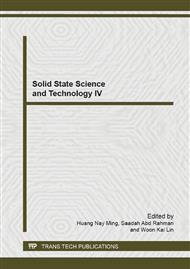[1]
M. D. Duca, et al., Surface modifications of polyvinylidene fluoride (PVDF) under rf Ar plasma, Polymer Degradation and Stability, vol. 61, pp.65-72, (1998).
DOI: 10.1016/s0141-3910(97)00130-4
Google Scholar
[2]
M. P. P. Larissa, Matheus, R. Chaud, Pedro A.P. Nascente, Rinaldo Gregario Jr Morphology of PVDF, P(VDF-TrFE) Copolymers, and PVDF/P(VDF-TrFE) blends, Acta Microscopica, vol. 12, p.125, (2003).
DOI: 10.4028/www.scientific.net/msf.403.83
Google Scholar
[3]
M. D. Rozana, et al., Effect of PTFE and OTS on the Ferroelectric Properties of PVDF-TrFE Thin Films , World Applied Sciences Journal, vol. 16, pp.1196-1202, (2012).
Google Scholar
[4]
M. A. Barique, Ohigashi H., Annealing effects on the curie transition temeperature and melting temperature of P(VDF-TrFE) single crystalline films, Polymer, vol. 42, p.4981, (2001).
DOI: 10.1016/s0032-3861(00)00937-x
Google Scholar
[5]
R. K. Dorai, M. J, plasma surface modification of polymers using athmospheric pressure, Plasma Science, p.329, (2002).
Google Scholar
[6]
K. Kimura, et al., Study on orientation mechanisms of poly(vinylidenefluoride-trifluoroethylene) molecules aligned by atomic force microscopy, Applied Surface Science, vol. 252, pp.5489-5494, (2006).
DOI: 10.1016/j.apsusc.2005.12.088
Google Scholar
[7]
Rozana Mohd Dahan, et al., Surface Modification of Polyvinylidenefluoride-Trifluoroethylene Film Using Argon Gas Plasma, Advanced Materials Research, vol. 626, pp.317-323 (2013).
DOI: 10.4028/www.scientific.net/amr.626.317
Google Scholar
[8]
S. Han, et al., Polymer surface modification by plasma source ion implantation, Surface and Coatings Technology, vol. 93, pp.261-264, (1997).
DOI: 10.1016/s0257-8972(97)00057-1
Google Scholar
[9]
R. M. Dahan, S.I. Ismail, Famiza Latif, M.N. Sarip, M.H. Wahid and A.N. Arshad, Dielectric Properties of Collagen on Plasma Modified Polyvinylidene Fluoride, American Journal of Applied Sciences, vol. 9, pp.694-699, (2012).
DOI: 10.3844/ajassp.2012.694.699
Google Scholar
[10]
I. Y, Surface modification of polymers for medical applications, Biomaterials, vol. 15, pp.725-736, (1994).
Google Scholar
[11]
K. R. Kull, et al., Surface modification with nitrogen-containing plasmas to produce hydrophilic, low-fouling membranes, Journal of Membrane Science, vol. 246, pp.203-215, (2005).
DOI: 10.1016/j.memsci.2004.08.019
Google Scholar
[12]
M. T. Meikun Fan, Maria Luiza Andrade, Alexandre G. Brolo, Silver Nanoparticles on a Plastic Platform for Localized Surface Plasmon Resonance Biosensing, Anal. Chem., vol. 82, p.6350–6352, (2010).
DOI: 10.1021/ac101495m
Google Scholar


